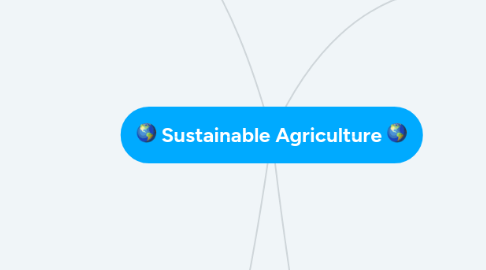
1. Crop Diversity
1.1. Monocultures
1.1.1. The practice of cultivating a single crop in an area in order to obtain optimal crop yields
1.1.1.1. Why?:
1.1.1.1.1. Higher efficiency
1.1.1.1.2. Less labor intensive
1.1.1.1.3. Need to meet high market demand
1.1.1.2. Cons:
1.1.1.2.1. Increased susceptibility to disease and drought
1.1.1.2.2. Depletion of soil nutrients
1.1.1.2.3. Pesticide resistance
1.1.1.2.4. Heavy amounts of agrochemicals in runoffs
1.1.2. According to the UN Food and Agriculture Organization (FAO), "the diversity of cultivated crops declined by 75% during the 20th Century and a third of today's diversity could disappear by 2050"
1.1.2.1. The world is depending on a diminishing number of varieties and crop species.
1.2. Vs.
1.3. Crop Diversity
1.3.1. The variance in genetic matierial by cultivating a variety of crops
1.3.1.1. Pros:
1.3.1.1.1. Improved resilience to disease, drought, and climate change
1.3.1.1.2. Long-term food security
1.3.1.1.3. Economic security
1.3.1.1.4. Reducing environmental degradation
1.3.1.1.5. Enables farmers to develop higher yield and more productive varieties due to more available genetic material
2. Chemical Use
2.1. Use of Chemicals such as herbicides and insecticides which kill weeds and insects and improve overall crop health(GMOs could fall here since they are man-made creations and cannot be found naturally
2.1.1. Conventional Agriculture
2.1.1.1. Farmers have lots of money and can automate the growing process and make it easier to produce more food yields at a cheaper price
2.1.1.1.1. How They Use It
2.1.2. Subsistence Agriculture
2.1.2.1. Farmers struggle to grow enough food for themselves and most do not consider exports as an options
2.1.2.1.1. How They Get Around It
3. Integrated Crop and Livestock
3.1. What is it?
3.1.1. Integrated crop and livestock is the combination of animals and crops on the same farm.
3.1.1.1. Sustainable agriculture implements this practice.
3.1.1.1.1. Animals consume farm-grown crops.
3.1.1.1.2. Animals also are not confined to pens.
3.2. Precedence
3.2.1. Historically, integrated crop and livestock was common.
3.2.1.1. In the mid-1900s, technological and economical advancement led to specialization in agriculture.
3.2.2. Today, many farms focus on one or the other, meaning that they sell crops off the farm or buy feed for their livestock.
3.2.2.1. Corn and soybean covers 85% of Midwest farmland.
3.2.2.2. Since WWII, cattle numbers have decreased by 52% in the Midwest.
3.3. Organism distribution
3.3.1. Landscape and forage sources determine the number and distribution of livestock.
3.3.1.1. Distribution of crops and livestock can be optimized to prevent soil erosion.
3.3.1.1.1. Row crops do best on level land.
3.3.1.1.2. Pastures can be placed on any sloped land.
3.3.1.2. Moving the livestock around is important.
3.3.1.2.1. If the livestock graze in an area for too long, vegetation will suffer.
3.3.1.3. Considering the carrying capacity of an area is important.
3.3.1.3.1. If too many livestock live in a small area, issues like the vegetation loss mentioned above will appear.
3.4. Animal confinement
3.4.1. Oftentimes, sustainable agriculture involves not confining livestock.
3.4.1.1. Animal confinement has many cons, but some pros.
3.4.1.1.1. Pros
3.4.1.1.2. Cons
3.5. Management of extreme weather conditions
3.5.1. The number of livestock may need to be reduced in the case of drought.
3.5.2. Grazing can reduce fire hazards by reducing fuel buildup. This is especially helpful in fire-hazardous areas like Mediterranean climates.
3.5.3. However, livestock can aid in the time of drought by consuming failed crops that normally would be thrown out.
3.6. Feed costs
3.6.1. Feed costs are the largest variable costs, so keeping these costs down benefits farmers.
3.6.1.1. Flexible farming and marketing can keep costs down
3.6.1.1.1. Flexible farming and marketing is the practice of feeding animals efficiently and sending livestock to market.
3.6.1.1.2. Flexible feeding and marketing can aid farmers by shielding them from economic fluctuations.
3.6.1.1.3. It also makes farm operations more efficient, along with cropping operations.
3.6.1.1.4. Feed largely comes from the farm, however some is purchased off the farm.
3.6.1.1.5. Feed costs can be kept down through monitoring animals and analyzing seasonal vegetation variations
4. Sensitve Land Management
4.1. Farmland is often lost due to over precipitation. The top soil or the protective layer is washed away by the rain water, exposing the highest quality soil on top. It makes the soil more vulnerable to weathering.
4.1.1. Solutions:
4.1.1.1. Ridge Tillage
4.1.1.1.1. Planted crops on 10-20 centimeter ridges that are formed during cultivation or after harvest. Plants are planted in the same spot every year.
4.1.1.2. Conservation Tillage
4.1.1.2.1. A method of soil cultivation that requires some of the previous harvest being left on the field through winter
4.1.1.3. No Tillage
4.1.1.3.1. Leaves the land untouched after harvest
